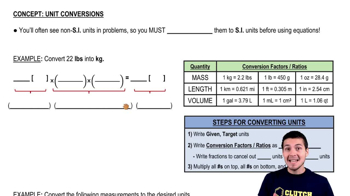Here are the essential concepts you must grasp in order to answer the question correctly.
Magnetic Field Due to a Current-Carrying Wire
A current-carrying wire generates a magnetic field around it, described by Ampère's Law. The strength of this magnetic field (B) at a distance (r) from a long, straight wire can be calculated using the formula B = (μ₀ * I) / (2π * r), where μ₀ is the permeability of free space and I is the current. This principle is essential for determining the magnetic field produced by the transmission line.
Recommended video:
Magnetic Force on Current-Carrying Wire
Conversion of Units
In physics, it is often necessary to convert units to ensure consistency in calculations. In this case, the magnetic field is expressed in teslas (T), while the Earth's magnetic field is given in gauss (G). The conversion factor is 1 G = 10^-4 T, which is crucial for comparing the magnetic field produced by the transmission line to the Earth's magnetic field.
Recommended video:
Health Effects of Electromagnetic Fields
The potential health effects of electromagnetic fields (EMF) generated by power lines have been a topic of research and debate. While some studies suggest a correlation between high EMF exposure and health risks, such as cancer, the scientific consensus indicates that the levels produced by typical power lines are generally considered safe. Understanding this context helps assess whether the calculated magnetic field poses any real health concerns.
Recommended video:
 Verified step by step guidance
Verified step by step guidance


